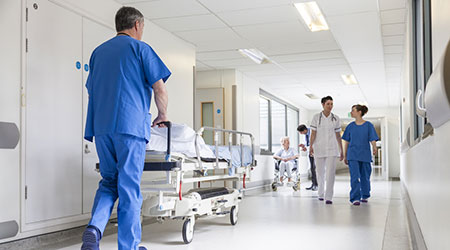Healthcare facilities have a very diverse set of needs, due to the various types of areas that involve the facility. From pharmacies and waiting rooms to laboratories and nurses’ stations, scrub areas and operating rooms, even restrooms and kitchens, their uses are different, but they all have one thing in common. Cleanliness!
One of the most important aspects of any area within a healthcare facility is maintaining a clean, hygienic environment. This is crucial to the safety of patients, staff, and visitors. Where there are more virulent strains of pathogens, the cleanliness of a healthcare facility could even impact the health of the general population, as staff and visitors can carry microbes outside the facility itself.
What encourages the proliferation of pathogens
Pathogens are most likely to proliferate on surfaces that are coarse, such as grout lines and unsealed concrete. They also thrive in areas where moisture can accumulate and in any type of indentation, nook, cranny, divot, crack and puncture. Unfortunately, when bacteria hide in these small and hard to reach areas, it can make it difficult to clean and mitigate their growth.
The problem with tile and resilient vinyl flooring
Tile flooring — including vinyl — has sharp edges and corners that can wear and crack due to the constant weight of carts, gurneys, and other wheeled equipment. Tile adhesives can also erode over time, loosening the tiles and grout. Porcelain, terrazzo, and other hard materials can be ground down and crumble, while resilient vinyl flooring—though considered seamless—is known to crack around cove areas, edges and welding seams. What do these flooring problems have in common? They can inadvertently aid in the growth of pathogens.
Along with potential durability issues, some flooring types may not withstand the use of chemicals used for cleaning and sterilizing healthcare facilities. This in turn can cause the flooring to become less effective, even to the point of substrate exposure. They may also stain easily, thus becoming less attractive. While appearance may not speak to the hygienic issues, it can certainly impact how the facility is viewed and the morale of both patients and staff.
Epoxies and urethanes provide seamless flooring
The most effective type of flooring for sterile medical areas is a seamless floor, as it minimizes the places in which microbes can grow. Epoxy and urethane flooring systems provide just that! Fortunately for healthcare facilities, a seamless floor can be both durable and beautiful.
They accomplish this in several ways:
• Direct application to the concrete - To begin with, resinous flooring systems are applied directly to a concrete slab, creating a solid bond to the concrete. There are no adhesive layers that can erode or come loose.
• Non-porous surface – Epoxies and urethanes are non-porous and grout free. Liquids stay at the top of a resinous flooring system instead of absorbing into the substrate or other porous flooring types. This allows for quick and easy clean up and minimizes potential pathogen growth.
• Coves base - A cove base is an integral part of the system, typically extending 6“ up the wall. This, essentially, creates a seamless area where the wall and floor meet, discouraging liquids from puddling around the perimeter of the room.
• Slope to drain – When a seamless floor is combined with a slope-to-drain design, virtually all liquids and cleaning fluids are washed down the drain and removed from the environment. A drier floor means fewer microbes.
• Easy maintenance – Epoxy and urethane systems do not require frequent waxing, polishing, or buffing. Simply wash down or clean according to hospital cleaning procedures.
Additional benefits of epoxies and urethanes
While maintaining sanitation undoubtedly tops the list of important actions for healthcare environments, they offer other benefits to consider when choosing flooring for a healthcare facility:
• High-performance and durability – Resinous flooring offers one of the longest lifespans of any type of finish. This can also help reduces downtime and cost of repairs.
• Customized skid resistance –In high foot traffic areas and in areas where water and other liquids are present, additional texture can be added to any coating system to create greater levels of traction and aid against slip and fall incidents.
• An array of customizable colors – Functional does not have to be boring. Resinous coatings can accommodate virtually any design or theme and be combined with graphics, icons, labels, directions, logos or any type of artwork. There are various types of decorative systems to choose from, including flake, quartz and metallic.
In summary, the seamlessness they afford for mitigating the growth of pathogens, along with greater durability and longevity, as well as their aesthetic flexibility make resinous finishes an excellent choice for healthcare facilities.
Kendall Youngworth is a Senior Marketing Specialist at Tennant Coatings.

 Building Sustainable Healthcare for an Aging Population
Building Sustainable Healthcare for an Aging Population Froedtert ThedaCare Announces Opening of ThedaCare Medical Center-Oshkosh
Froedtert ThedaCare Announces Opening of ThedaCare Medical Center-Oshkosh Touchmark Acquires The Hacienda at Georgetown Senior Living Facility
Touchmark Acquires The Hacienda at Georgetown Senior Living Facility Contaminants Under Foot: A Closer Look at Patient Room Floors
Contaminants Under Foot: A Closer Look at Patient Room Floors Power Outages Largely Driven by Extreme Weather Events
Power Outages Largely Driven by Extreme Weather Events